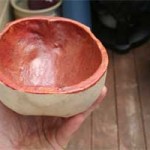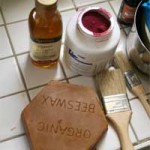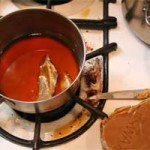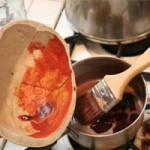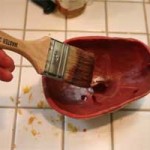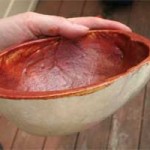Skullcup Care
An Essential Guide to Safeguarding the Health of Tibetan
and Western Dharma Teachers and Students
The human skullcup (to-pa) is an essential part of tantric practice. A standard feature of empowerments, mantra accumulations and offering rituals, the skullcup‘s remarkable qualities and effects have been explained at length elsewhere. For the ngakpa or yogi, it also serves as an eating bowl, being self-arisen (rang-jung) and unfabricated, like mind itself.
But many thopas used by lamas and Westerns alike have been internally coated with paint (traditionally red), to ensure a water-proof vessel. While this does stop leaking of the alcohol they usually contain, and protects the bone from eventual damage, this is far from a safe practice.
Toxic Dangers
Enamel (oil-based) and acrylic points are highly toxic, containing dozens of chemicals that are, both long- and short-term, poisonous to the human body. This includes dozens of solvents, toluenes, chemical pigments and metal-based toxins (such as arsenic, barium, aluminum and cadmium). These easily leech out into a solvent such as alcohol, especially after several hours of soaking. Particularly in older skullcup specimens\’”or those painted in the East\’”these paints may even have lead and other ingredients now banned in the West. While one may not drink from a skull cup often or in great quantities, even a single poisoning with chemical toxins can have create serious organ damage. As a holistic doctor I have witnessed many such cases over the years. Paint toxins particularly effect the kidney, liver and nervous system, especially in the elderly or those whose health is already compromised by chronic systemic conditions like diabetes.
The Traditional Method
Apart from these physical issues, these sacred items, prepared according to very specific tantric methods and terma instructions, have a unique energy and a powerful impact on the substances that they contain: Even food eaten from a skullcup with the right characteristics is imprinted with remarkable qualities.
Painting the skullcup with hardware store paint is hardly a traditional method. Thus in order to help preserve the health of our precious resource of Rinpoches, lamas and dharma students, and to safeguard the vibrant effect of these tantric tools, I devised the following method, based on the old ways.
Safety First
If your teacher or lama, East or West, has a skullcup, use this essential method to safeguard their health and that of their students! Old paint does not have to be removed\’”which in any case is usually impossible due to the porousness nature of bone. Just use this method directly over the previous surface.
Ingredients
All the following are readily available in stores or online. I have listed the source of organic materials (my preference) below.
1. Sesame Oil (preferred due to high flash point)
2. Beet Root Power (organic preferred)
3. Beeswax
4. Horse hair brush and cooking pot
Organic Beeswax: From Nature with Love
Organic Beet root powder: Oregon’s Wild Harvest
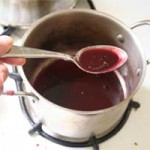
Mix
Add about 2 tablespoons of beet powder to 3-4 tablespoons of oil. While the beet powder can be added directly to hot wax, for best results, the beet powder and oil should be mixed and gently heated together. This dissolves fairly rapidly.
If you use too much oil, the final wax is too soft. If you add no oil, the wax will be extremely hard and difficult to ever remove.
Wax Preparation
Meanwhile, in another pot, melt beeswax at low heat, not allowing it to steam or simmer. A fist-sized piece is usually adequate (depending on the size of the fist and the skull!).
The beeswax needs to be chopped into smaller pieces before cooking. This requires a heated or very sharp knife to shave pieces off. Beeswax is extraordinarily hard!
Use plastic under your entire work area, and try not to spill any on the stove. Cleaning hardened beeswax is not fun!
Painting
Add the oil to the hot wax and start painting the inside of the skullcup. A natural bristle brush works well. Start with a thin overall layer, then gradually build up, putting several layers on. It hardens quickly, so this is no problem. Keep the wax on low heat so that it does not harden while you are working. When through, check and touch up any patchy areas. Also make sure the rim or edge has a nice coating as well.
Clean Up
When all is done, immediately put your brushes in hot water, though they will never again be “clean.” The pot is best cleaned by mild heating and scraping.
If you have any hot wax left, you can always run it through your kangling, using a hot coat hanger to ensure a clear channel from end to end.
After Care
After each use, make sure the thopa is cloth dried and left in the air to dry for several hours. Of course, it should never be left empty, but contain flowers, jewels or other offerings.
If used for eating, these rules apply strongly. Rather than immersing in water, clean with a damp cloth and air dry. Use natural essential oils for added cleanliness, if needed.
May this method benefit and preserve the precious dharma and its practitioners in these perilous and dangerous times!.
